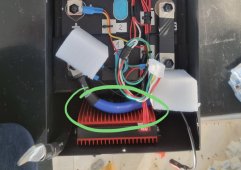Lippasti
New Member
- Joined
- Feb 4, 2022
- Messages
- 6
Hi all,
as a long time reader and now, first time poster, I have just built my first LiFePo4 battery with 304Ah Eve cells. Find below some pics and specs. Happy for any constructive feedback or if anyone spots a mistake. The battery is intended for our offroad vehicle
(Very conservative) BMS Settings:
I do have some questions though:



as a long time reader and now, first time poster, I have just built my first LiFePo4 battery with 304Ah Eve cells. Find below some pics and specs. Happy for any constructive feedback or if anyone spots a mistake. The battery is intended for our offroad vehicle
- EVE 304AH cells with rubber foam in between cells as spacer
- Daly 250A BMS & active balancer (can optionally be plugged in if I notice too much cell drift)
- Double bus bars, taped & with plastic cover on the screws (positive terminal also has one but wasn't on the photo)
- Custom fabricated metal housing
- Pack tied with filament tape and hollow-chamber plastic board (no idea what this is called in english) as insulator against the housing (visible in the lid)
(Very conservative) BMS Settings:
- High-voltage: 3,4V (Total: 13,6V)
- Low-voltage: 2,85V (Total: 11,4V)
- Diff voltage: 0,26V
- Balance open start voltage: 3.0V
- Balance open diff voltage: 0.05V
- Chg high temp protect: 42°C
- Chg low temp protect 3°C
- disChg high temp protect: 55°C
- disChg low temp protect: -15°C
I do have some questions though:
- The laser welded studs seem to have a very small surface contact area. What is the maximum amperage they can handle?
- The Daly 250BMS only has a 2AWG wire which seems a bit low for currents up to 250A. Do you see any issues on running a continuous 2-2.3kW (150-170A) load?
- There is a very minor voltage between the main positive terminal and the case but no voltage between each of the cells and the case. So my suspicion is, that this is from the BMS being screwed onto the case. Do you think this is an issue?






